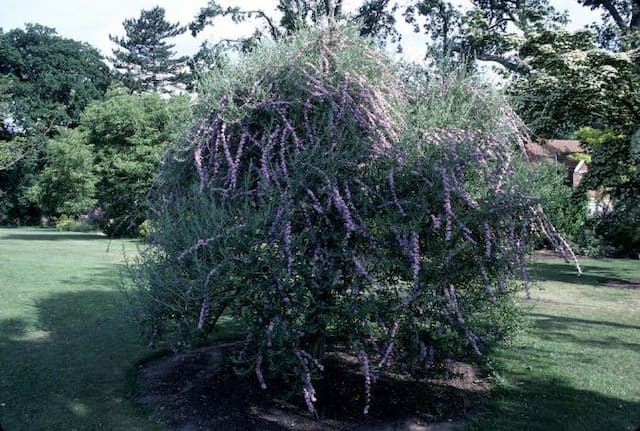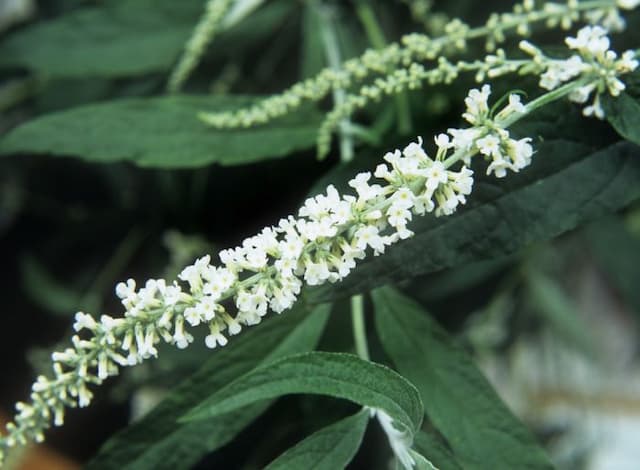Butterfly Bush Buddleja davidii 'Dart's Purple Rain'

ABOUT
Buddleja davidii 'Dart's Purple Rain', commonly known as butterfly bush, is an ornamental plant known for its vibrant and alluring floral display. This cultivar boasts dense clusters of deep purple flowers, which form elongated, conical shapes known as panicles. Each individual flower is tubular and small, with four petals that flare outwards, giving it a delicate and somewhat frilly appearance. The color intensity of the blossoms often attracts a wide variety of pollinators, including butterflies and bees. The flowers are often abundant and cover the branches from mid-summer to autumn, infusing the garden with rich hues and a pleasant fragrance. The foliage of the butterfly bush is equally attractive, with leaves that are lance-shaped, featuring pointed tips and somewhat serrated edges. These leaves are arranged in an opposite pattern along the stems, creating a bushy and lush appearance. The leaves display a dark green color on the upper surface and a lighter, almost gray-green shade on the underside. Moreover, the plant has a graceful, arching shape which adds to its ornamental value. The stems are woody, and the overall structure can be a prominent feature in a garden, serving as a beautiful backdrop for other flowering plants or as a centerpiece in a butterfly garden. As its name implies, the butterfly bush is particularly renowned for attracting butterflies, and 'Dart's Purple Rain' excels at this, making it not only a visual delight but also a valuable contributor to supporting local wildlife.
About this plant
 Names
NamesFamily
Scrophulariaceae.
Synonyms
Butterfly Bush, Summer Lilac, Orange Eye.
Common names
Buddleja davidii 'Dart's Purple Rain'.
 Toxicity
ToxicityTo humans
Butterfly Bush (Buddleja davidii) is not commonly known to be toxic to humans. There are no widespread reports of significant toxic effects from ingesting or touching parts of the Butterfly Bush, and it is generally considered safe in a garden setting. However, as with any plant, individual allergies or sensitivities can exist, and care should always be taken when handling plants to avoid potential irritation or allergic reactions.
To pets
Butterfly Bush (Buddleja davidii) is also not widely recognized as toxic to pets. It does not appear on most lists of poisonous plants for pets, including both dogs and cats. Therefore, it's generally considered to be of low toxicity risk to domestic animals. Nonetheless, the consumption of non-food items, including non-toxic plants, can cause gastrointestinal upset in pets, so it is advisable to prevent your pets from ingesting this or any ornamental plant.
 Characteristics
CharacteristicsLife cycle
Perennials
Foliage type
Deciduous
Color of leaves
Green
Flower color
Purple
Height
6 feet (1.83 meters)
Spread
4 feet (1.22 meters)
Plant type
Shrub
Hardiness zones
5-9
Native area
China
Benefits
 General Benefits
General Benefits- Attracts Pollinators: Buddleja davidii 'Dart's Purple Rain', commonly known as Butterfly Bush, is known for attracting butterflies, bees, and other beneficial pollinators to the garden.
- Low Maintenance: This plant requires minimal care once established, making it suitable for gardeners of all skill levels.
- Drought Tolerant: Butterfly Bush has good drought resistance, making it a fitting choice for water-wise gardens.
- Fast Growing: The plant grows quickly, providing a rapid display of flowers and foliage.
- Long Blooming: It has a long flowering season, often from early summer to autumn, offering extended visual interest.
- Landscape Uses: Butterfly Bush is versatile for landscaping, suitable for use in borders, beds, and as a focal point.
- Deer Resistant: Generally resistant to deer, making it a good option for gardens in areas with deer populations.
 Medical Properties
Medical PropertiesThis plant is not used for medical purposes.
 Air-purifying Qualities
Air-purifying QualitiesThis plant is not specifically known for air purifying qualities.
 Other Uses
Other Uses- Artisanal Paper Making: The fibrous stems of butterfly bush can be used in crafting handmade paper, providing texture and interest to the final product.
- Natural Dye Source: The flowers of the butterfly bush can be used to create natural dyes for coloring textiles, yielding a range of soft purples and mauves.
- Photography Subjects: Butterfly bush's vivid flowers are excellent for macro and nature photography, attracting photographers who wish to capture the intricate beauty of the plant.
- Landscape Drawing Reference: Artists can use the distinctive shape and purple flowers of butterfly bush as a subject for landscape drawings and watercolor paintings.
- Eco-friendly Gardening Demonstrations: Butterfly bush can be incorporated into workshops showcasing how to attract pollinators and create wildlife-friendly gardens.
- Flower Pressing: The flowers of butterfly bush are suitable for pressing and can be used in botanical art and crafts such as greeting cards and bookmarks.
- Decorative Dried Arrangements: Dried butterfly bush flowers can retain their shape and color, making them ideal for use in long-lasting, decorative dried floral arrangements.
- Edible Flower Garnish: Although not commonly known for culinary uses, the flowers can occasionally be used as an edible garnish for desserts or drinks after proper identification and ensuring they are free from pesticides.
- Plant Photography Workshops: Butterfly bush can be a focal point for teaching plant and flower photography, providing ample opportunities for participants to practice depth of field and composition.
- Habitat Education: The butterfly bush can be used in educational settings to teach about plant-insect interactions and the role of native and non-native flora in supporting wildlife.
Interesting Facts
 Feng Shui
Feng ShuiThe Butterfly Bush is not used in Feng Shui practice.
 Zodiac Sign Compitability
Zodiac Sign CompitabilityThe Butterfly Bush is not used in astrology practice.
 Plant Symbolism
Plant Symbolism- Transformation: The Buddleja, commonly known as the Butterfly Bush, often symbolizes change and transformation due to its ability to attract butterflies, which are a universal symbol of change owing to their metamorphosis process.
- Attraction: This plant is also indicative of attracting good things into one's life, as its vivid colors and sweet nectar draw in numerous pollinators.
- Renewal: Associated with growth and rejuvenation, the Butterfly Bush blooms vigorously and can regenerate from severe pruning, symbolizing the potential for new beginnings.
- Beauty: With its long, showy panicles of purple flowers, the Buddleja is often a symbol of beauty in the landscape, suggesting an appreciation for natural aesthetics.
- Hope: As a plant that is hardy and resilient, the Buddleja can represent hope and the ability to endure challenging conditions.
 Water
WaterButterfly Bush requires average watering, meaning it prefers moist but well-drained soil. During its growing season in the spring and summer, it's best to water it once a week with about 1 gallon of water, depending on weather conditions. If the weather is particularly hot or dry, you may need to water it twice a week. In the winter, reduce watering to every two weeks or less, as the plant is dormant and requires less moisture. Make sure not to overwater, as Butterfly Bush does not tolerate soggy soil.
 Light
LightButterfly Bush thrives in full sun, which means it requires at least six hours of direct sunlight each day. The best spot for this plant is in an area where it can receive unfiltered sunlight throughout the day. It can tolerate some light shade, but its flowering might be reduced.
 Temperature
TemperatureButterfly Bush is hardy and can tolerate a range of temperatures. It can survive winter temperatures as low as -20 degrees Fahrenheit and can handle summer heat well above 100 degrees Fahrenheit. For optimal growth and flowering, temperatures between 60 and 90 degrees Fahrenheit are ideal. Always ensure good airflow to prevent fungal issues, which can arise in high humidity.
 Pruning
PruningPruning Butterfly Bush helps to encourage more flowers and maintain an attractive shape. Prune in late winter or early spring before new growth begins, cutting back the previous year's growth to about a foot from the ground. This timing allows the plant to produce vigorous new stems that will flower in the same year. Pruning should be done annually to ensure the best display of blooms.
 Cleaning
CleaningAs needed
 Soil
SoilThe Butterfly Bush prefers well-draining soil rich in organic matter with soil pH between 6.0 and 7.0. A good soil mix for Buddleja davidii 'Dart's Purple Rain' would consist of garden soil, compost, and a small amount of sand or perlite to ensure adequate drainage.
 Repotting
RepottingButterfly Bushes are typically grown outdoors and do not require frequent repotting. If grown in containers, repotting every 2-3 years or when the plant outgrows its current pot is sufficient.
 Humidity & Misting
Humidity & MistingThe Butterfly Bush tolerates a wide range of humidity levels and does not have specific humidity requirements, thriving in the typical outdoor environment.
 Suitable locations
Suitable locationsIndoor
Place in a sunny spot; water when soil is dry.
Outdoor
Full sun, well-drained soil; water deeply when dry.
Hardiness zone
5-9 USDA
 Life cycle
Life cycleBuddleja davidii 'Dart's Purple Rain', commonly known as Butterfly Bush, begins its life cycle as a seed, germinated in well-drained soil with sufficient warmth and light. Once sprouted, the seedling rapidly grows into a shrub, with distinctive long, tapered leaves and vigorous branching. Throughout spring and summer, it enters a vegetative growth phase, accumulating resources and expanding its root and shoot systems. During late summer, it transitions to the reproductive phase, producing cone-shaped inflorescences with dense clusters of purple flowers, which are highly attractive to butterflies and other pollinators. After pollination, seeds are produced and dispersed, completing the cycle. In colder climates, the plant may die back to the ground in winter, entering a dormant phase before regrowing from the rootstock with the return of warmer weather.
 Propogation
PropogationPropogation time
Spring to Summer
The most popular method of propagation for Buddleja davidii 'Dart's Purple Rain', more commonly known as the Butterfly Bush, is through semi-hardwood cuttings. This is typically done in late summer. For best results, choose healthy stems that have begun to mature but are not fully woody. Cut a section about 4 to 6 inches (10 to 15 centimeters) long, making the cut just below a leaf node. Remove the lower leaves, dip the cut end into rooting hormone powder, and then insert it into a well-draining growing medium like a mix of peat and perlite. Cover the cutting with a plastic bag to retain moisture and place it in a warm spot with indirect light. Roots should develop within a few weeks, after which the new plant can be transplanted into the garden.


![Butterfly bush [Florence]](/_next/image?url=https%3A%2F%2Fplants-admin.emdemapps.com%2Fimages%2Fplants%2F%2Fimages%2F604b5f52d7bb1.png&w=640&q=75)
![Butterfly bush [Marbled White]](/_next/image?url=https%3A%2F%2Fplants-admin.emdemapps.com%2Fimages%2Fplants%2F%2Fimages%2F604b63353832a.png&w=640&q=75)


![Aloha [Honey Dark Yellow]](/_next/image?url=https%3A%2F%2Fplants-admin.emdemapps.com%2Fimages%2Fplants%2F%2Fimages%2F604b53868dde8.png&w=640&q=75)
![Aloha [Raspberries and Cream]](/_next/image?url=https%3A%2F%2Fplants-admin.emdemapps.com%2Fimages%2Fplants%2F%2Fimages%2F604b57c0a7fff.png&w=640&q=75)
